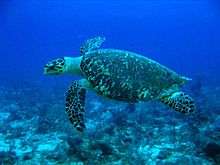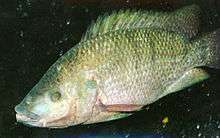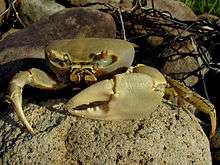Fauna of Barbados
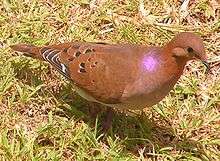
The fauna of Barbados is less diverse than that of other Caribbean islands. The island's fauna has been greatly affected by anthropogenic activities; these range from habitat destruction to the introduction of non-native species. Species best able to adapt to the presence of humans have persisted, while those unable to adapt have generally fared poorly.
Origin of Barbadian fauna
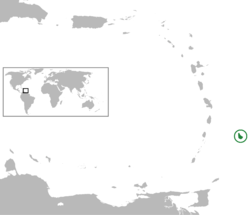
The island of Barbados was formed by tectonic uplift and is younger than surrounding lesser Antillean islands, which are primarily of volcanic origin. Avian colonization has therefore occurred recently relative to the geological age of the island, accounting in part for the paucity of endemic species relative to neighboring islands.[1]
Species capable of crossing the sea barrier by flight enjoyed a comparative advantage; helping explain why avian species are more numerous than other animal groups, such as mammals. In addition to natural colonization of the island by animals, humans have contributed to the faunal composition of the island, through species introductions (intentional and accidental).[2]
Mammals
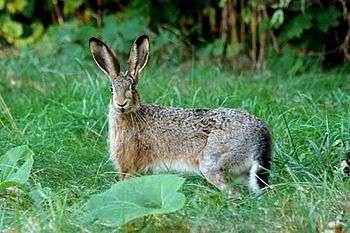
Mammals are a poorly represented group on the island, composed almost entirely of introduced species.[2] The Norway rat (Rattus norvegicus), house mouse (Mus musculus), European hare (Lepus europaeus), Indian mongoose (Herpestes javanicus), and green monkey (Cercopithecus aethiops sabaeus) are the most notable examples. Pigs were introduced by the Portuguese in 1563 as a future food source; the introduction was successful and a feral pig population persisted up until the point of British settlement of the island, after which they became extirpated.[3]
The now extinct Barbados raccoon (Procyon gloveralleni) is considered to have been endemic to the island; however even this species may have been introduced by Amerindians in pre-historic times.[2] There is also some indication that the Barbados raccoon was in fact a subspecies of the common raccoon (Procyon lotor), rather than a distinct species.[4]
The only remaining native mammals are a number of bat species;[5] the most common of which is the velvety free-tailed bat (Molossus molossus),[5] which emerges at dusk to feed on insects.
A breed of sheep known as the Barbados Blackbelly sheep originated in Barbados, it has been exported to various nations around the world including the United States where it is sometimes called affectionately "Barbado Sheep".
Marine mammals are not frequently seen in Barbadian waters; some species however, particularly bottlenose dolphins (Tursiops truncatus) and humpback whales (Megaptera novaeangliae), are occasionally seen offshore.[3]
Feral dogs and cats, introduced by humans, also occur on the island.
Birds
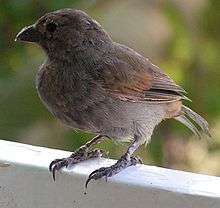
Birds are fairly well represented on the island; most having adapted well to the presence of humans.
Icterids such as the Carib grackle (Quiscalus lugubris) and the shiny cowbird (Molothrus bonariensis), which often parasitizes the nests of the former species, are quite common.
Seedeaters include the black-faced grassquit (Tiaris bicolor) and the grassland yellow finch (Sicalis luteola), known locally as the grass canary. Introduced from South America the grassland yellow finch is now faced with extirpation due to poaching for the pet trade. Until recently considered a non-sexually dimorphic subspecies of the Lesser Antillean bullfinch (Loxigilla noctis), the Barbados bullfinch (Loxigilla barbadensis) has recently been elevated to species level.[6]
There are two species of tyrant flycatcher found on the island, the gray kingbird (Tyrannus dominicensis) which is quite common; often seen perched on power lines,and the Caribbean elaenia (Elaenia martinica) which is more rare.
Representatives of the family Columbidae include the zenaida dove (Zenaida aurita), common ground dove (Columbina passerina), scaly-naped pigeon (Patagioenas squamosa), and the ubiquitous rock pigeon (Columba livia). Another species, the eared dove (Zenaida auriculata), which was previously reported as an occasional visitor to the island, has now established a breeding population.[7]
Nectar consuming species include the Antillean crested hummingbird (Orthorhyncus cristatus), green-throated carib (Eulampis holosericeus), and the bananaquit (Coereba flaveola).
Heron species include, the cattle egret (Bubulcus ibis) and the fairly rare green heron (Butorides virescens). A recent addition to the island's avifauna is the little egret (Egretta garzetta), which has recently colonized the island from Africa.[7]
Early European visitors reported finding a species of parrot on the island,[8] which subsequently became extinct. Currently parrots are represented by a few escaped or released individuals which have formed feral populations; most notably is a small population of the orange-winged parrot (Amazona amazonica) which has become established among several Roystonea palms in the Belleville district of the capital Bridgetown.[9] The brown-throated parakeet (Aratinga pertinax), introduced to the island, is rarely seen.
The scaly-breasted thrasher (Allenia fusca) may have become extirpated from the Island. A resident race of the yellow warbler (Dendroica petechia petechia) is also threatened, mostly due to loss of its mangrove swamp habitat;[10] the last major refuge for this species is the Graeme Hall Swamp in the south of the Island,[11] However some reports suggest the species is expanding its range on the island.[9]
Species which may be encountered in wetland areas include the masked duck (Nomonyx dominica), American coot (Fulica americana), and the common moorhen (Gallinula chloropus)[11] The southern lapwing (Vanellus chilensis), a shorebird, has recently bred upon the island; having spread to Barbados from Trinidad and Tobago and northern South America.[12]
Substantial numbers of migratory birds either over-wintering on the island, or en route from North America to South American wintering grounds are seen annually.[2] Shorebirds are one such group of birds which stop off in Barbados during migration; tens of thousands however, lured to artificial wetlands, are shot annually for sport.[13]
Reptiles
The green iguana (Iguana iguana) formerly resided on the island before being extirpated. An endemic species of anole lizard, (Anolis extremus), and the introduced tropical house gecko (Hemidactylus mabouia) are both common species; while Underwood's spectacled tegu (Gymnophthalmus underwoodi), and a native species of Kentropyx lizard (Kentropyx borckiana) are rarer on the island.[14]
The red-footed tortoise (Geochelone carbonaria) is widely kept in captivity; it was likely introduced to the island, as no reports of it were made by early European explorers to the island.[2]
Populations of an endemic Liophis grass snake (Liophis perfuscus) have been devastated as a result of predation by the introduced Indian mongoose; with no confirmed sightings of the species since 1961. Another snake species, Mastigodryas bruesi and the world's smallest snake, Leptotyphlops carlae, have also been recorded from the island.[2]
Currently there are two species of sea turtle which nest in Barbados, the hawksbill turtle (Eretmochelys imbricata), and the leatherback turtle (Dermochelys coriacea). Though not nesting on the island, the green sea turtle (Chelonia mydas) does forage in nearshore seagrass beds. Coastal infrastructure, such as hotel properties, has encroached upon the nesting grounds of sea turtles, while coastal lights also detrimentally impact upon nesting females.
Amphibians
The cane toad (Bufo marinus) from South America and the Johnstone's whistling frog (Eleutherodactylus johnstonei) encompass the islands amphibian community.[15] The introduction of the cane toad was done as a biological control aimed at insect pests of sugarcane;[2] as has been the case elsewhere, lack of predators to control the cane toad has led to uncontrolled populations in some areas.
Fish
Freshwater fish
The wild form of the guppy (Poecilia reticulata) is native to Barbados as well as Trinidad and northern South America.[16] Introductions of aquarium varieties of the guppy into the wild mean that it may be impossible to distinguish between original and fancy varieties.
Originally intended for aquaculture, tilapia species including, Oreochromis mossambicus,[17] and Tilapia zilli have become widely established in ponds and streams across the island.[11][18]
Brackish water fish
Brackish water species also occur, particularly in coastal wetlands such as the Graeme Hall Swamp; one such species is the mangrove rivulus (Rivulus marmoratus),[11] notable for its unique ability of self fertilization.[19] A resident and isolated population of Atlantic tarpon, (Megalops atlanticus) has become established in the Graeme Hall Swamp.[11]
Invertebrates
Crustaceans
Terrestrial crab species found on the island include Cardisoma guanhumi and Gecarcinus lateralis.[20]
See also
References
- ↑ Lovette, Irby J.; Seutin, Gilles; Ricklefs, Robert E.; Bermingham, Eldredge (March 1999), "The assembly of an island fauna by natural invasion: Sources and temporal patterns in the avian colonization of Barbados", Biological invasions, 1 (1): 33–41, doi:10.1023/A:1010090414598
- 1 2 3 4 5 6 7 Government of Barbados (2002), A National Biodiversity Strategy & Action Plan For Barbados: To the Convention on Biological Diversity (CBD), archived from the original on September 28, 2007, retrieved 2007-09-04
- 1 2 Creswell, Joel, Marine Mammals in Barbados, retrieved 2007-09-04
- ↑ World Conservation Monitoring Centre (1996). "Procyon gloveralleni". IUCN Red List of Threatened Species. Version 2006. International Union for Conservation of Nature. Retrieved 2007-09-04.
- 1 2 Corrie, Damon, First Nations Vacations - About Barbados, retrieved 2007-09-04
- ↑ Birdlife International, What's new (2007), retrieved 2007-09-05
- 1 2 Massiah, Edward, Birding Facts Birding Resources by the Fat Birder, retrieved 2007-09-05
- ↑ Clark, Austin H. (1905), "The West Indian Parrots" (PDF), The Auk, XXII (1): 337–344, doi:10.2307/4069996, retrieved 2007-09-05
- 1 2 Caribzones, Barbados birdwatching, retrieved 2007-09-05
- ↑ Bachynski, K.; Kadlec, M. (2003), "Dendroica petechia" (On-line), Animal Diversity Web, retrieved 2007-09-05
- 1 2 3 4 5 Graeme Hall Nature Sanctuary, graemehall.com, retrieved 2007-09-05
- ↑ Wilson, Julie (2007-07-16), Watson: Bird hunting a concern, The Daily Telegraph, retrieved 2007-09-04
- ↑ Shemilt, Michael (2007-08-21), Killing fields of Barbados, The Daily Telegraph, retrieved 2007-09-03
- ↑ Corrie, Damon, Barbados Reptiles and Amphibians, archived from the original on September 29, 2007, retrieved 2007-09-05
- ↑ The Caribbean Herpetological Society, Reptiles and Amphibians of Barbados West Indies (PDF), archived from the original (PDF) on June 28, 2007, retrieved 2007-09-05
- ↑ zipcodezoo, Poecilia reticulata, archived from the original on September 30, 2007, retrieved 2007-09-05
- ↑ Barbados National Assessment Report (NAR) on The Implementation Of The Barbados Programme Of Action (BPOA), 2004, Section 5.1, retrieved 2007-11-09
- ↑ Tilapia and the Environment, retrieved 2007-09-05
- ↑ Parker, Christoph; Oxenford, Hazel A., Environment and development in coastal regions and in small islands, retrieved 2007-09-05
- ↑ Harris, RR (1977), "Urine production rate and water balance in the terrestrial crabs Gecarcinus lateralis and Cardisoma guanhumi" (PDF), The Journal of Experimental Biology, 68: 57–67, PMID 894187

.jpg)
